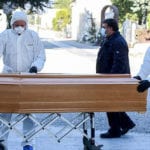 Crime
Crime  Crime
Crime  Technology
Technology 10 Hilariously Over-Engineered Solutions to Simple Problems
 Miscellaneous
Miscellaneous 10 Ironic News Stories Straight out of an Alanis Morissette Song
 Politics
Politics 10 Lesser-Known Far-Right Groups of the 21st Century
 History
History Ten Revealing Facts about Daily Domestic Life in the Old West
 Weird Stuff
Weird Stuff 10 Everyday Products Surprisingly Made by Inmates
 Movies and TV
Movies and TV 10 Actors Dragged out of Retirement for One Key Role
 Creepy
Creepy 10 Lesser-Known Shapeshifter Legends from Around the World
 Animals
Animals 10 Amazing Animal Tales from the Ancient World
 Gaming
Gaming 10 Game Characters Everyone Hated Playing
 Crime
Crime 10 Terrifying Serial Killers from Centuries Ago
 Technology
Technology 10 Hilariously Over-Engineered Solutions to Simple Problems
 Miscellaneous
Miscellaneous 10 Ironic News Stories Straight out of an Alanis Morissette Song
Who's Behind Listverse?

Jamie Frater
Head Editor
Jamie founded Listverse due to an insatiable desire to share fascinating, obscure, and bizarre facts. He has been a guest speaker on numerous national radio and television stations and is a five time published author.
More About Us Politics
Politics 10 Lesser-Known Far-Right Groups of the 21st Century
 History
History Ten Revealing Facts about Daily Domestic Life in the Old West
 Weird Stuff
Weird Stuff 10 Everyday Products Surprisingly Made by Inmates
 Movies and TV
Movies and TV 10 Actors Dragged out of Retirement for One Key Role
 Creepy
Creepy 10 Lesser-Known Shapeshifter Legends from Around the World
 Animals
Animals 10 Amazing Animal Tales from the Ancient World
 Gaming
Gaming 10 Game Characters Everyone Hated Playing
10 People Who Died Ridiculous Deaths
Perhaps it’s the influence of the movies, but these days, we tend to expect death to be a solemn, dignified, occasion, where the dying person is surrounded by loved ones who hold their hand while listening to their final words, whispered in a failing voice. The end comes peacefully and unremarkably.
Unfortunately, not everyone gets to experience a dignified death. And for some people from history, their demise was very undignified indeed. This, of course, makes these deaths no less tragic for the victims and their families, but it does make it difficult to keep a straight face at the funeral. Here are a few examples.
10 Thomas Midgley Jr.
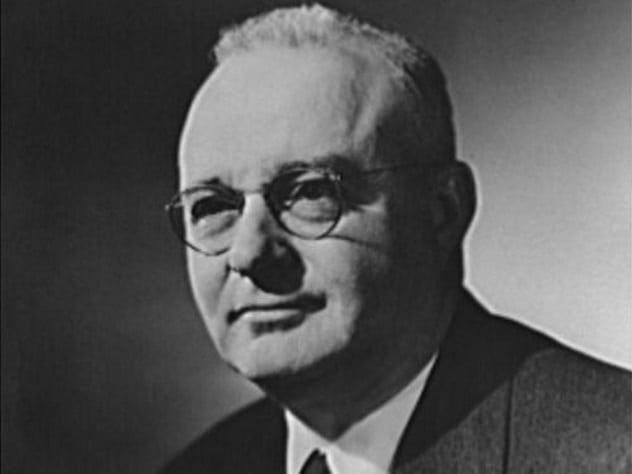
Thomas Midgley Jr. was a chemical engineer who made a number of valuable scientific discoveries. He received four medals from the American Chemical Society during his career and was admitted to the American Academy of Sciences. He sounds like a sensible sort of man.
Midgley was also an amateur inventor. He registered 117 patents, including one for a mechanical hoist to help him out of bed, which he invented after he contracted polio. However, the device malfunctioned, and Midgley became entangled in the ropes and was strangled.[1]
Perhaps that one needed a second draft.
9 Marcus Garvey
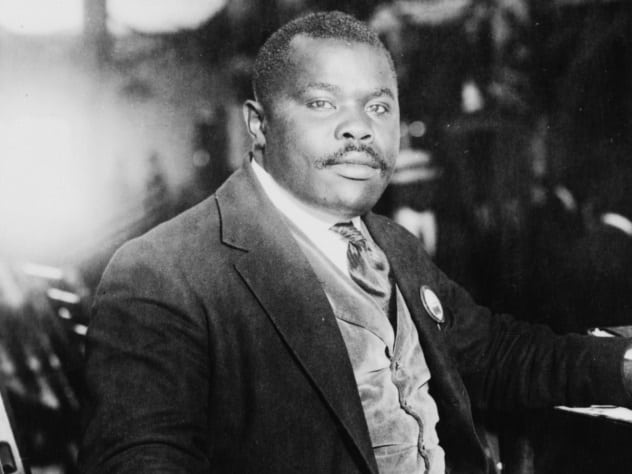
Marcus Garvey was a civil rights campaigner long before Rosa Parks ever rode a bus. He founded the Universal Negro Improvement Association in 1914, which urged African Americans to be proud of their heritage and to return to Africa, if they wanted. To this end, he founded the Black Star Line, a foundation which raised money to pay the passage home for any black person who needed it, and he also tried, unsuccessfully, to persuade the Liberian government to set aside land on which they could settle.
Though it is fair to say that his efforts weren’t particularly successful, Garvey nevertheless worked tirelessly for the betterment of black Americans. So, he could be forgiven for being upset when he read a number of unkind obituaries after he was mistakenly reported to have died. The next day, letters and telegrams came pouring in, and Garvey collapsed in his chair. The shock of his reading about his own death caused Garvey to have a stroke, which killed him.[2] (He’d already had one stroke, from which he was recovering when the false news of his death broke.)
8 Harry Houdini
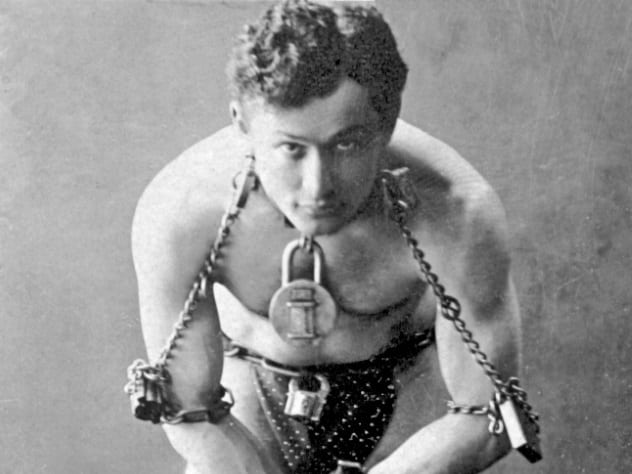
Harry Houdini, the famous magician and escapologist, cheated death many times, particularly when he hung upside down in the Chinese Water Torture Cell while shackled in a straitjacket. If any man could be said to be destined for an interesting death, it is Houdini.
Unfortunately for him, his actual end was a little more prosaic. At first thought to be suffering from appendicitis, Houdini was rushed to hospital after one of this shows.
However, earlier in the evening, students from McGill University had visited Houdini as he was preparing to go onstage. Houdini had reportedly boasted in the past that his stomach muscles were so tight that he could withstand the hardest blows, and he invited one of the students to try his luck after he asked Houdini about this. The young man was, perhaps, a little overenthusiastic, and he punched Houdini hard in the stomach four or five times. Houdini was caught by surprise before he contracted his muscles, and the blows ruptured his appendix.
Despite this, Houdini continued with his show and was rushed to the hospital immediately the curtain fell. The banality of his demise was too much for many, and there have been many rumors about the “real” cause of his death ever since.[3]
7 The Unfortunate Victims Of The London Beer Flood

Death by beer may sound like a desirable way to go. For the inhabitants of Tottenham Court Road in 1814, though, it didn’t seem quite so appealing.
Men were working at the Horse Shoe Brewery when a huge vat, holding up to 9,000 barrels of beer, burst open, sending a “tsunami” of porter 4.6 meters (15 ft) high sweeping through the streets. It flooded the nearby slums, quickly filling up cellars where whole families lived crammed together.
Eight people died in the flood, including at least one child. The basements were filled with the strong, black beer, and the cleanup took the rescuers an unusually long time. The brewery wasn’t fined for causing the disaster, which was deemed to be “an unavoidable act of God,” and was even given a tax break to help it recover. The poor victims, however, received nothing.[4]
6 Clement L. Vallandigham
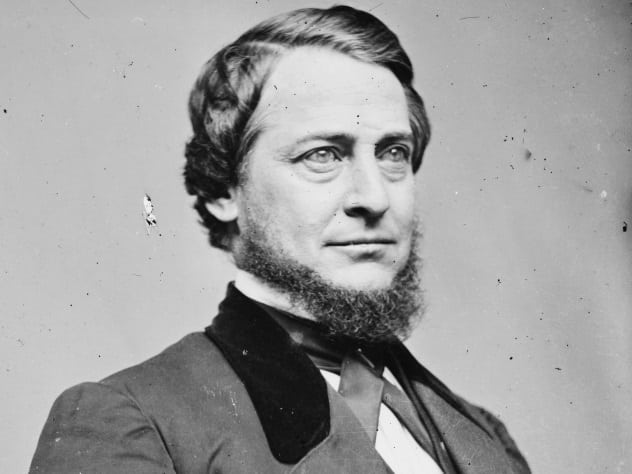
Clement L. Vallandigham was a politician during the US Civil War and a noted lawyer. He was a determined Confederate sympathizer and declared that Abraham Lincoln was destroying not only the Constitution but civil liberties as well. He was briefly imprisoned during the war and then exiled to the Confederacy, where he kept up a war of words against the Union.
By 1870, he had resigned himself to defeat and returned to his career as a lawyer. On June 17, 1871, Vallandigham was defending a man on a murder charge. He intended to prove that the victim had, in fact, shot himself while pulling his pistol. He was conferring with other defense attorneys and decided to demonstrate how this could have happened. Thinking that the gun he chose as a prop was not loaded, he promptly shot himself. Vallandigham was mortally wounded and died at the scene.[5]
Vallandigham’s client was acquitted.
5 Franz Reichelt
Franz Reichelt was a man with big dreams. He made his living as a tailor, running a moderately successful business from his apartment. His obsession, however, was flight. Reichelt wanted to use his tailoring skills to design a parachute that would enable people to fly safely. He designed his own suit, which looked like a conventional aviator’s outfit with rods attached to a silk canopy. In total, the suit weighed around 9 kilograms (20 lb), and the parachute, when spread out, occupied around 31 square meters (340 ft2).
In 1911, Reichelt was spurred on by a prize of 10,000 francs offered by Aero Club de France for the first person who could successfully demonstrate a working parachute. He refused to be deterred by the comments of the Aero Club judges, who maintained that his suit was not safe and not viable as a parachute. Convinced in his own mind of the efficacy of his parachute, he petitioned the Eiffel Tower authorities to let him test the suit by jumping off a suitably tall structure.
Though the authorities tried to dissuade him, they did eventually grant Reichelt permission to test his suit, and on February 4, 1912, he climbed the tower with his invention strapped to his back. A large crowd gathered to watch, and two cameras recorded the event, even as friends and family tried to dissuade him. But Reichelt was determined to be the first person to build a working parachute.
On the count of three, Reichelt jumped and dropped like a stone to his death. Perhaps it was as well that he died instantly so that he never need know that two days earlier, an American had successfully parachuted off the Statue of Liberty.[6]
4 The Molasses People
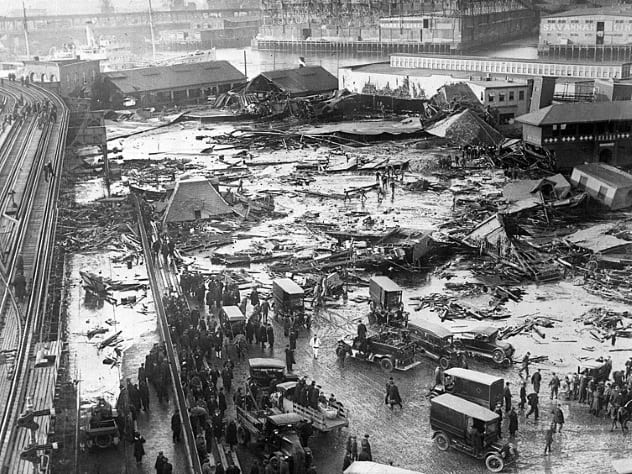
January 15, 1919, was a unseasonably warm day in the middle of a Boston winter. The inhabitants of Commercial Street, and those who worked around the surrounding railroad, were just settling down to their lunch when a 15-meter-tall (50 ft) tank containing 8.7 million liters (2.3 million gal) of molasses burst open, sending the molasses flooding onto the streets.
Though it sounded like the plot of an Uncle Remus tale, in fact, the force of the impact was enough to rip buildings from their foundations. Twenty-one people died in the explosion, and many more were injured.[7]
The cause of the explosion was hotly contested, with the company alleging that the debacle was caused not by their negligence but by a terrorist attack. After a protracted legal battle, they were ordered to pay compensation to the victims.
Recent scientific experiments have concluded that the temperature that day contributed to the disaster, making the molasses more viscous so that it behaved like quicksand, dragging victims down into the treacle. They also believe that the temperature between the molasses in the barrel and new molasses piped into it just before the explosion may have set off a sticky chain reaction.
3 The Duke Of Clarence

Born in 1449, George Plantagenet, the duke of Clarence, was the brother of King Edward IV. After the king had refused permission for the duke to marry, George began to plot against him. Edward, wise to his brother’s treachery, had the duke arrested and charged with treason.
He was brought before Parliament and accused of preparing for rebellion. Both houses of Parliament passed a bill approving his execution at the Tower of London. There were lots of ways he could have died. Popular execution methods at the time included hanging, drawing, and quartering as well as burning at the stake.
But George Plantagenet was a royal. Perhaps that is why he was allowed to choose the manner of his own death. His choice was somewhat unusual. He is said to have chosen to be drowned in a vat of his favorite wine.[8]
Well, if you’ve got to go . . .
2 Adolf Frederick

Adolf Frederick was the king of Sweden. And kings, even Swedish ones, attend a lot of banquets. In February 1771, Frederick attended a particularly lavish banquet that was being held in preparation for Lent. Knowing that the following 40 days would feature fasting, the guests at the table felt free to really, shall we say, “indulge.”
Frederick was a particularly enthusiastic diner and managed to pack away lobster, caviar, various fish dishes, and a pile of sauerkraut, all washed down with plenty of champagne. For dessert, Frederick, a man who knew what he liked, consumed 14 dishes of semlor—a kind of sweet bread roll served in a bowl of warm milk.
King Frederick developed “complications in his digestive tract” and died soon after from overeating.[9]
1 Grigori Rasputin
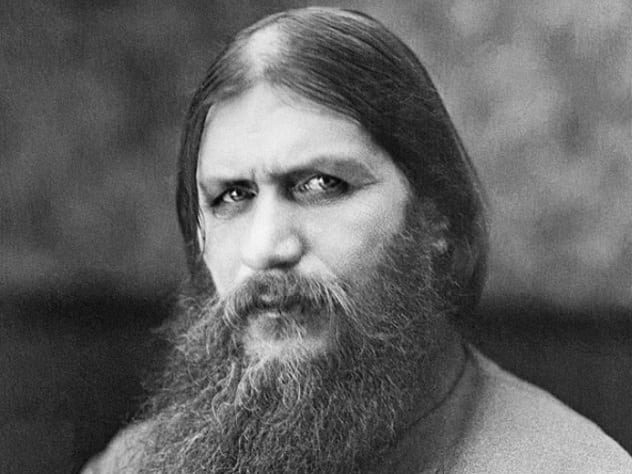
Grigori Rasputin, the Mad Monk who was so favored by the Russian tsarina Alexandra Feodorovna, had a death that was almost as unbelievable as his life.
Rasputin developed his mesmeric hold over the Russian imperial family because of his ability to help their son Alexei control his hemophilia. His enemies, on the other hand, believed he was plotting to undermine Russian foreign policy. There were rumors that he was a sex maniac and even that he had become a lover to the tsarina.
Afraid of his growing political influence, Prince Yusupov and Vladimir Purishkevich, a member of the Russian parliament, fed Rasputin cakes laced with poison. He ate the cakes but did not succumb to the poison.
When the poison failed to work, Purishkevich allegedly fired four shots into Rasputin’s back. Other sources claim Rasputin was shot in the chest. A surviving photograph of his body clearly shows a bullet wound in his forehead.
What happened later is disputed, but Prince Yusupov later recorded in his diary: “This devil who was dying of poison, who had a bullet in his heart, must have been raised from the dead by the powers of evil. There was something appalling and monstrous in his diabolical refusal to die.”[10]
Legend has it that before he finally died, his attackers, possibly with Rasputin’s reputation as a womanizer in mind, castrated him and threw him into the freezing cold Neva River, where he eventually succumbed to death. (Others have concluded that he was already dead before being thrown in the river.) Rasputin had earlier written to Tsar Nicholas and predicted that he would be murdered and that his death would bring down the Russian Empire. “Without me,” he said, “everything will collapse.”
Spooky!
Ward Hazell is a writer who travels, and an occasional travel writer.
Read about more crazy ways people have died on 10 Of History’s Most Cartoonish Deaths and 10 Incredibly Bizarre Ways People Died In Ancient Greece.






